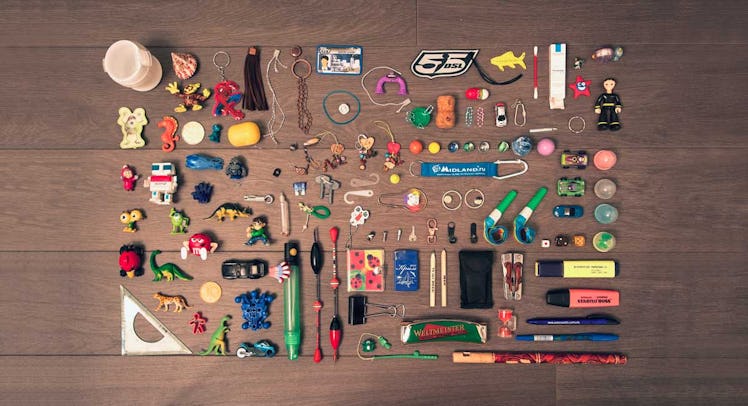7 Essential Toys For Every Stage Of Your Kid’s Life, As Selected By Toy Hall Of Fame Experts
Basically, you can throw everything else away.

At some point, you’ll realize that you’re just guessing about the best toy for your kid. That’s because a ton of them are going to eventually be relegated to the bottom of the toy box, which is basically the equivalent of a toy dive bar. It’s where the cast-offs like Battlefield Earth action figures and Playmobil’s Transportation Safety Administration playset smoke, drink beers and talk about how they “coulda been somethin’” with haunted, faraway looks in their plastic eyes.
RELATED: The 12 Best Toys from the 2018 International Toy Fair
What you need is a pro to close that toy dive down. Enter The Strong Museum Of Play and its National Toy Hall of Fame. The nearly 20-year-old institution has been enshrining the most timeless toys since 1998 based on criteria that includes: icon status, longevity, fostering discovery, and innovation. Basically, these are the toys that are always on top.
ALSO: The 10 Best New Maker Toys to Help Kids Learn STEM Skills
Deborah McCoy, Assistant Vice President for Education at The Strong recently pawed through the inductees presumably littering the floor of the Hall’s family room. Here are her suggestions for iconic toys that aren’t only incredibly easy to come by, but also perfect for your kid at each major stage in their childhood development.
Toys For Your Infant (0-To-3-Months-Old)
Blanket
You always knew that Linus was a trendsetter, but you might be surprised that the humble blanket is thought of as a kids toy. However, when considering it can become just about anything from a fort to a cape, it makes a ton of sense. It also has a very long life that starts at infancy.
“Blankets are often children’s first comfort item,” explains McCoy. “They teach children about texture and help children begin to feel secure.”
Toys For Your Baby (3-To-9-Months-Old)
Bubbles
“Children at this age explore the world through their senses,” says McCoy. “Bubbles give even young infants something interesting to look at and track with their eyes.”
The Toy Hall of Fame website also points out that bubbles are great for teaching scientific concepts like color formation and comparative sizing (which thankfully your partner never fully grasped). Not to mention, says McCoy, “bubbles also offer an opportunity for a fun interaction with an adult, something that builds relationships.”
Toys For Your Cruiser (9-To-18-Months-Old)
Ball
“Balls are often among babies’ first toys,” McCoy says. “They learn about cause and effect as they attempt to hold or roll the ball. They engage their senses as they touch the ball and watch it roll.”
A good ball will cause a kid to abandon even the most flashy, noisy, plastic, popular toy out there. That’s right, Hatchimal. Ball has your number. (No wonder they’re swearing in their sleep).
Toys For Your Toddler (18-To-24-Months-Old)
Baby Doll
They wet, they cry, they drink milk, and they creep you the hell out when you find one staring at you in the dark of the night with those dead eyes. But for your kid, a baby doll is a catalyst to some serious imagination play.
“Children at this age are just beginning to engage in imaginative play,” explains McCoy. “Baby dolls allow children opportunities to take on the role of parent and to practice representational competence (in other words, pretending).”
Although, for some kids, role playing their parents may not include a ton of competence. This isn’t true for your kid, obvs.
Toys For Your Preschooler (2-To-3-Years-Old)
Crayola Crayons
As the only branded toy in McCoy’s picks, they must be pretty dang special. And according to McCoy, they are.
“Crayons provide a simple way for children to explore color and to represent their thinking by drawing,” she says. “Three year olds may begin to make first attempts at marks with crayons and assign it meaning, one of the first steps in writing development.”
Which might make you feel better when the development occurs on your walls.
Toys For Your Kindergartner (3 to 6 years)
Alphabet Blocks
These lettered-cubes are an awesome bang for your buck because they foster learning while fueling the imagination.
“Playing with alphabet blocks is a fun way for children to learn letter recognition,” McCoy explains. Adding, “All types of blocks promote learning about shapes, geometry, and spatial relations. Blocks also promote imaginative play as children build pretend structures.”
Plus, you’ll have a grand time amusing yourself by using them to spell 4-letter words when nobody’s looking.
Toys For Your Elementary Schooler (7 to 14 years)
Bike
For a 7-year-old, B-I-K-E spells freedom. There’s nothing like the sound of a bike chain on a sunny afternoon. But your average bike does so much more, according to McCoy, “Bikes promote large motor (physical) skills like coordination, balance, and agility. Bikes also promote the development of confidence and independence.”
This article was originally published on